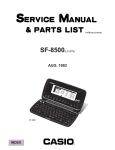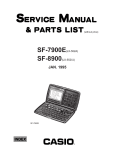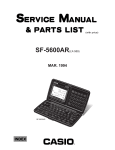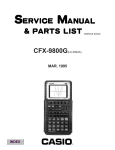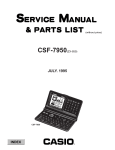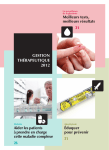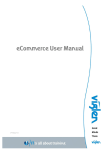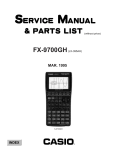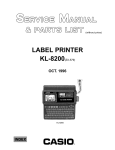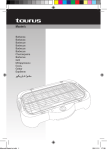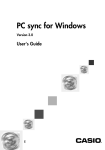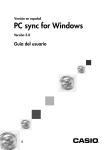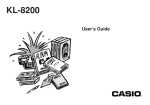Download Casio SF-8350 Specifications
Transcript
(with price) SF-8350R(LX-523) JAN. 1994 SF-8350R R CONTENTS 1. SCHEMATIC DIAGRAM................................................................................................ 1 2. SPECIFICATIONS ......................................................................................................... 5 3. TO REPLACE THE BATTERY ...................................................................................... 6 4. ERROR MESSAGE ....................................................................................................... 7 5. TO RESET THE DIGITAL DIARY ................................................................................. 7 6. TO SAVE THE DATA TO OTHER MACHINE ............................................................... 8 7. TO CHECK THE MEMORY CAPACITY...................................................................... 11 8. DISASSEMBLY ........................................................................................................... 12 9. BLOCK DIAGRAM ...................................................................................................... 14 10. CIRCUIT EXPLANATIONS 10-1. System chart ................................................................................................. 15 10-2. Power supply circuit .................................................................................... 16 10-3. Battery voltage detection ............................................................................ 19 10-4. CPU pin description (µPD3055GF002-2BA) ............................................... 21 10-5. Gate array pin descriptions (µPD65005G-452-22) ..................................... 21 10-6. Power supply chip IC pin descriptions (SC371015FU) ............................. 21 10-7. Character generator ROM pin descriptions (HD62063B01) ..................... 22 10-8. Operation program ROM pin descriptions (µPD23C2001EGW342) ......... 23 10-9. RAM pin descriptions (µPD43256AGU-10/12/15LL) .................................. 23 11. DIAGNOSTIC OPERATION ........................................................................................ 24 12. TROUBLE SHOOTING................................................................................................ 29 13. PARTS LIST ................................................................................................................ 32 14. PCB VIEW ................................................................................................................... 34 15. ASSEMBLY VIEW ....................................................................................................... 35 1. SCHEMATIC DIAGRAM 1-1. Main PCB —1— 1-2. Display PCB —2— 1-3. Key Matrix —3— 2. SPECIFICATIONS Data storage: Telephone/business card/memo/schedule data storage/recall, calendar display, marker, phrase memory, secret area, editing, capacity display, auto display Clock: Average of accuracy ±3 seconds per day under normal temperatures; worldtime, schedule alam, daily alarm Calculation: 12-digit arithmetic calculations, constants for + / – / × / ÷, independent memory, percentages, square roots, 24-digit approximations, date calculations, other mixed calculations Messages: Selectable language: English, German, French, Italian, Spanish, Swedish, Polish, Czech, Hungarian, Russian General: Display element: Memory capacity: Main component: Power supply: 32-column × 6-line LCD 64 KB (56,006 bytes) LSI Main Power Supply — Two CR2032 lithium batteries Backup Power Supply — One CR2032 lithium battery Power consumption: 0.05W Battery life: Main: Approximately 120 hours (Repeated cycle of 1-minute data input into Telephone Directory followed by 10-minute display. Operation temperature of 20°C) Approximately 150 hours (Continuous display in Telephone Directory. Operation temperature of 20°C) Backup: 5 years if main batteries are replaced as soon as they become weak. 1 year if dead main batteries are left in the unit. Auto power off: Approximately 6 minutes after last key operation Operating temperature: 0°C ~ 40°C (32°F ~ 104°F) Dimensions: Unfolded: 10.5H × 152W × 155.2mmD (3/8"H × 6"W × 61/8"D) Folded: 17.9H × 152W × 78mmD (3/4"H × 6"W × 31/16"D) Weight: 152.5g (5.4 oz) including batteries Current consumption: Power switch TYP. [µA] MAX [µA] 8 29 ON 1,447 13,258 ON (Operating) 6,707 19,958 OFF —5— 3. TO REPLACE THE BATTERY A) To replace the main batteries Before replacing the main batteries, note the following precautions. • Do not remove the back-up battery from the SF Unit while main batteries are removed. • Be sure to replace both batteries at the same time, and do not use an old battery with a new one. 1. Remove the screw that hold the battery compartment cover in place. 2. Remove the battery compartment cover by sliding it in the direction indicated by the arrow in the illustation. 3. Slide the main battery holder in the direction indicated by the arrow. 4. Remove both old batteries and replace with two new ones. • Use two new batteries. Wipe the surfaces of the batteries with a soft, dry cloth. Make sure that the positive (+) sides of the batteries are facing up (so you can view the positive sides as the batteries lie in the battery compartment). 5. Replace the battery holder. 6. Replace the battery compartment cover and fasten it in place using the screw. B) To replace the back-up battery Before replacing the back-up battery, note the following precautions: • Do not remove the main batteries from the SF Unit while back-up battery is removed. • Be sure to replace the back-up battery at least once a year. 1. 2. 3. 4. 5. 6. 7. Remove the screw that hold the battery compartment cover in place. Remove the battery compartment cover by sliding it in the direction indicated by the arrow in the illustration. First , remove this sticker from the back-up battery holder. After removing this sticker, take the screw off that secures the back-up battery holder in place, and then remove the battery holder. Remove the old battery and replace it with a new one. • Wipe the surfaces of the battery with a soft, dry cloth. Make sure that the positive (+) side of the battery is facing up (so you can view the positive side as the battery lies in the battery compartment.) Replace the back-up battery holder and fasten it in place using the screw, and replace the sticker over the battery holder. Replace the battery compartment cover and fasten it in place using the screw. —6— 4. ERROR MESSAGE Message Meaning Action Text specified for search does not exist. Correct or change specified text. Wrong password entered. Enter correct password. MEMORY FULL! No more room in memory for storage of data. Delete unnecessary data items from memory. DATA ERROR! CONSULT YOUR OWNER'S MANUAL UNDER "DATA ERROR" Abnormal data caused by strong impact, static electricity, etc. Consult the "DATA ERROR" section on page 3 of owner's manual. DATA ITEM NOT FOUND! PASSWORD MISMATCH! 5. TO RESET THE DIGITAL DIARY Before describing the RESET operation, a note of WARNING — The following procedure will erase all data stored in memory, including marked data items. Be sure to perform the RESET operation only if you wish to clear all data. To reset the SF Unit's memory 1. Switch on power and press the RESET button with a thin, pointed object. The following message appears on the display. DELETE ALL DATA ITEMS STORED IN MEMORY ? YES Y / NO N * Important! Note that the following operation will clear everything stored in the unit's memory. To avoid accidental erasure of important data, be sure to perform this operation only while the system language is set to your native language. See page 2 of owner's manual for infomation on how to change the system language. 2. Press Y to reset the SF Unit and clear everything from its memory. To abort the procedure without clearing anything, press N . —7— Following the RESET operation, the Home Time Display appears. The initial settings of the SF Unit after reset are shown below. HOME TIME: G.M.T. JAN/1/1993 (FRI) 12:00 AM 12-hour format WORLD TIME: New York Daily Alarm: 12:00 PM Sound: Schedule alarm Daily alarm Key Character input: CAPS System Language: English 6. ON OFF ON TO SAVE THE DATA TO OTHER MACHINE SF-8350R can transfer customers data to other SF-8350R with memory protection only when replacing the LCD or the outer case. How to transfer the data. * Before connecting the cable (SB-60 or SB-62), be sure to reset the slave machine to clear all data. Important! * You can not perform data communications with the CASIO SF-A series of SF Units (SF-A10,etc.). * Be sure to replace the connector covers on the SF units when you are not performing data communications. 1) Turn off the power switch and connect the two units using the cable (SB-60 or SB-62) as shown in the drawing. 2) Turn on the power switch of each machine. 3) The slave machine must be set the date of Feb. 3rd, 1901 into the memory under the calculator mode. Operation: CAL ON CLEAR/AC 1 9 0 1 TIME DATE 2 TIME DATE 3 TIME M+ DATE R If you don't set the date, the "PASSWORD" isn't transferred to the slave machine. —8— 4) Check the hardware parameters, and if the units have another condition, reset as follows. To change the hardware parameters, press the , , and cursol keys. To set the hardware parameters, press the set key. *** HARDWARE PARAMETERS PARITY BIT LENGTH7 bits BPS 1200 EVEN 2400 *** ODD 7 bits 4800 NONE 8 bits 9600 TEL TEL FUNCTION 4 4 5) Set up the slave machine. 1 While in the Calender Display, Telephone Directory, Business Card Library, Memo Mode, or Schedule Keeper, press the FUNCTION key followed by 4 to select " DATA COMMUNICATION", and the following menu appears. TEL FUNCTION 4 1 2 3 4 5 6 SEND RECEIVE PRINT HARDWARE PARAMETERS DATA TO RAM CARD PEN PRINTING TEL 2 Press 2 to select "RECEIVE" and the following display appears to indicate that the slave machine is ready to receive data. 2 RECEIVE OK ! TO STOP, PRESS ESC TEL 6) Set up the customer's machine. 1 While the transmitting unit is in the Calender Display, Telephome Directory, Business Card Library, Memo Mode, or Schedule Keeper, press the FUNCTION key followed by 4 to select "DATA COMMUNICATION", and the following menu appears. TEL FUNCTION 4 1 2 3 4 5 6 SEND RECEIVE PRINT HARDWARE PARAMETERS DATA TO RAM CARD PEN PRINTING TEL —9— 2 Press 1 to select "TRANSMIT" and the following menu appears. 1 ONE DATA ITEM 2 MODE DATA ITEMS 3 ALL DATA ITEMS 1 — SEND — TEL 3 Press 3 to select "ALL DATA ITEMS", and the following display appears to confirm whether you wish to proceed. SEND ALL DATA ITEMS ? 3 YES SET / NO ESC TEL 4 Press the SET key to proceed with the data transmission, or press ESC if you wish to cancel. SET NOW SENDING ! TO STOP, PRESS ESC Data are transmitted in the sequence of Telephone Directory data, Business Card Library data, Memo data, Schedule Keeper data and Calendar data. * If the customer's machine uses full memory, it takes about one minute and ten seconds for this transferring. * The following messages appear on the display of the receiving unit when a problem occurs during data communications. All data transferred up to display of the message is retained in memory, but data communication is terminated. TEL BUSINESS CARD MEMO SCHEDULE If one of the following error messages appear, press the , , , , HOME TIME , WORLD TIME , CAL , CALENDAR key, to clear the error message. Then, take corrective action and try data communication again. — 10 — Message STOPPED ! 7. Cause • ESC key pressed on transmitting or receiving unit. • Memory area of receiving unit full. • Battery power drops below a certain level. TRANSMIT ERROR ! Cable connection broken or abnormal noise in cable. MEMORY FULL ! Memory area of receiving unit full. TO CHECK THE MEMORY CAPACITY The memory Capacity display tells you how much total memory is used for storage of Telephone Directory, Business Card Library, Memo, Calendar, and Schedule Keeper data. It also shows the percentage of total memory used, and how much total memory area remains. Press the CAPA key to check the current memory capacity. Following the memory reset operation, the display will appear as follows. 56006 0 0 When the percentage of memory used reaches 100%, you will not be able to enter any more data into memory. — 11 — 8. DISASSEMBLY (SF-8350R) 1) To open display unit 1. Remove the key switch sheet from the display frame with care using a sharp tweezers and remove 2 screws, then remove the display back cover. 2. Remove the blind plate of hinge and then release the 2 screws of hinge cover. 3. Release the 5 screws of display PCB and remove the display PCB. — 12 — 2) To open battery cover and back cover 1. Release the one screw of battery cover and remove the battery cover. 2. Remove the batteries. (Refer section 3 in this manual.) 3. Release the 8 screws of the back cover. Then, remove the back cover. 4. To check the circuit by oscilloscope, apply the power to main PCB as follow: External Power supply Switch GND Prepare some 2P switch for Main switch. +6V +3V Prepare some power supply for + 6V and +3V. — 13 — 9. BLOCK DIAGRAM LCD 192 X 48 dots CD401-TS S32~S111 S0~S31 C0~C47 S112~S191 LCD DRIVER LCD DRIVER LCD DRIVER MSM6585AV -Z-358B MSM6585AV -Z-358B MSM6585AV -Z-358B DATA BUS TO KEYBOARD LCD DRIVE VOLTAGES V1 ~ V4, VREG CPU POWER SUPPLY CHIP FOR LCD µPD3055GF002-2BA SC371015FU VDD OPEN (OFF) LOCK (ON) ROM MAIN SWITCH (Character Generator) CARD LOCK SWITCH GND HD62063B01 FREE (OFF) LOCK (ON) Power supply circuit ROM (Operation Program) µPD23C2001EGW342 NOTE GATE ARRAY RAM µPD65005G-452-22 µPD43256AGX10/12/15LL X 2 PCS. TX, RX — 14 — INTERFACE FOR DATA TRANSMISSION & DATA RECEPTION 10. CIRCUIT EXPLANATIONS 10-1. System chart Generally, SF-8350R is working with the following steps. VDD 11 "H" (Pin30) (Pin31) 12 PDB 2 (Pin3) VDD VO1 VREG,V1~V4 Output for LCD drive Power supply chip SC371015FU (Pin2) VDD1 GND VDD2 (Pin20) (Pin32) 1 (Pin17) (Pin39) VDD VOT GND Gate array (Pin29) (Pin24) LSI µPD65005G-452-22 VIN MON Open SWO VOB LSO (Pin35) (Pin25) (Pin40) Batteries CR-2032 X 2 pcs. 4 3 13 "H" "L" "L" Transistor Q1 "H" (Pin2) VDD 2 MHz 10 (Pin69) (Pin45) (Pin41) V2ON INIT1 OSCI 9 (Pin1) (Pin3) (Pin40) OSCO VDD VDD VDD (Pin70) 14 INT0 OFF CPU GND "H" MAIN SWITCH SW µPD3055GF002-2BA (Pin36) 6 "L" 5 ON VCC EO KIO KAC (Pin54) (Pin53) (Operation program) 15 "H" "L" GND ROM (Pin30) (Pin22) µPD23C2001EGW342 CEB "L" 7 8 16 ADDRESS ADDRESS BUS DATA BUS 17 9. 10. 11. 12. 13. 14. 15. CPU oscillation is generated. Output "H" from V2ON terminal. Output "H" from VOT terminal. Output all LCD drive voltages. Output "L" from VOB terminal. Apply VDD to ROM. CPU sends ROM chip enable signal from EO terminal. 16. CPU sends address to ROM. 17. CPU receives data from ROM. 1. Supply 6V to VDD1 and VDD2. 2. Output VDD (4.5V). 3. 4. 5. 6. 7. 8. DATA Output "L" from SWO terminal. Output "H" from LSO terminal. Main switch ON. Input "L" to SW terminal. Output "L" from KAC terminal. Push power on button switch. — 15 — 10-2.Power supply circuit 1) Power supply chip SC371015FU + C8 21 18 + C7 20 17 16 R8 R9 R10 The IC SC371015FU is power supply chip for SF8350. When IC SC371015FU receives a Voltage 6V (CR-2032 × 2 pcs.) at the terminal VDD1(Pin No.2), the regulated voltage VDD (4.3~4.7V) will be applied to the VDD lines. The outputs Vss (VREG) and V1~V4 are the LCD drive voltages. When the terminal PDB becomes "H", those voltages are generated by IC SC371015FU and capacitors C7 and C8 (ESCT1AY335R) and applied to LCD driver IC MSM6385AV-Z-358B. The resistors R8~R10 are used for dividing voltage V1~V4. VREG 8 15 V1 14 V2 POWER SUPPLY CHIP 13 V3 SC371015FU 9 10 11 V4 12 V COMP1 V COMP2 VO1 VDD1 VDD2 6 7 2 1 VDD (4.3 V ~ 4.7 V) 19 LCD DRIVE VOLTAGE PDB 31 GND1 32 GND2 22 Value (Approx.) [V] Contrust : Min. Contrust : Max. VSS(VREG) -3.5 -6.4 V1 +3.4 +3.1 V2 +2.5 +1.7 V3 -1.5 -3.6 V4 -2.5 -4.9 FROM GATE ARRAY VOT terminal CR2032 Memory battery CR2032 CR2032 Main batteries The V comp1 and V comp2 outputs are the battery voltage detection outputs. According to VDD1 and VDD2 voltages, V comp1 and V comp2 will change the status as follows: OUTPUTS V COMP 1 V COMP 2 STATUS " H " STATUS " L " When the batteries voltage When the batteries voltage is more than 4.7 V. is less than 4.6 V. When the batteries voltage When the batteries voltage is more than 4.5 V. is less than 4.4 V. — 16 — 2) Gate array When VDD is applied from power supply IC SC371015FU to gate array uPD65005G-45222, gate array will send "L" signal to active the main switch signal from terminal SWO. Also, gate array will send "H" signal to release the INT0 terminal of CPU from LSO terminal. The terminal CSB is for the chip select of gate array. This signal is sent from CPU terminal CS2. And when the VDD is applied to CPU, CPU will send "H" signal to CSB terminal. GND Open (Pin 23) (Pin 24) TO MAIN SWITCH "L" (Pin 40) LSI MON SWO GATE ARRAY "H" TO CPU INT0 terminal (Pin 70) (Pin 25) µPD65005G-452-22 LSO (Pin 39) (Pin 17) VDD GND CSB (Pin 22) "H" FROM CPU CS2 terminal (Pin 28) 3) Main switch and power on switch VDD MAIN SWITCH (Pin36) SW "L" CPU KAC "L" ON GATE ARRAY (Pin40) "L" µPD3055GF002-2BA (Pin54) OFF SWO µPD65005G-452-22 KIO (Pin53) "H" POWER ON SWITCH When the main switch is set to on position, SW terminal of CPU becomes "L", then CPU will send "L" signal to KAC terminal to enable the system power on. The KI0 terminal is "H" when VDD is applied to CPU. Therefore, when pressing the power on switch, CPU will generate a clock pulse (2 MHz) for start up the system. — 17 — 4) Power supply for LCD (Pin30) "H" (Pin69) CPU (Pin31) PDB VOT INT1 V2ON µPD3055GF002-2BA "H" (Pin45) (Pin29) POWER SUPPLY CHIP VIN SC371015FU GATE ARRAY µPD65005G-452-22 LCD drive voltages VREG,V1~V4 When the system is start up, CPU will send "H" signal to VIN terminal of gate array from V2ON terminal. Then, gate array will send "H" signal from VOT terminal to release interruption signal INT1 of CPU and also, it will be sent to PDB terminal of power supply chip to generate LCD drive voltages. 5) ROM driving transistor VDD (Pin1) R4 " L " (Pin35) (Pin2) Transistor Q1 (Pin3) VOB (Pin30) VCC GATE ARRAY µPD65005G-452-22 VDD E0 ROM µPD23C2001 DATA CPU EGW342 ADDRESS µPD3055GF002-2BA After gate array send VOT signal, gate array send "L" signal from VOB terminal to base terminal of transistor Q1. Then, the VDD is applied to ROM (operation program), CPU can read a ROM program data by E0 signal. — 18 — 10-3.Battery voltage detection (Pin32) (Pin22) (Pin1) GND1 GND2 (Pin7) (Pin79) Power Supply Chip SC371015FU (Pin6) VCOMP1 (Pin37) VCOMP2 P7 ONMK VDD1 CPU VDD2 (Pin19) µPD3055GF002-2BA CR-2032 X 2 Main batteries The power supply IC chip SC371015FU has two kind voltage detection circuit in it. According to the batteries input voltage, the detection outputs V comp1 and V comp2 will change the status as follow: VCOMP2 (Pin27) BLI Gate Array µPD65005G-452-22 Batteries Voltage VCOMP2 More than about 4.6V "H" Less than about 4.6V "L" VCOMP1 Batteries Voltage VCOMP1 More than about 4.4V "H" Less than about 4.4V "L" When CPU receive VCOMP2 detection signal, the machine shows "MAIN POWER SUPPLY BATTERIES GETTING WEAK! REPLACE!" on the display. And when the batteries voltage is weak more (approx. 4.53V), as the VCOMP1 detection signal becomes "L". The machine will operate an auto power off operation. — 19 — 10-4.CPU pin description (µPD3055GF002-2BA) Pin No. Name In/Out Status Status Description of ON Pulse GND Pulse Pulse Pulse H H Pulse Pulse H H H H L L H L Pulse H H H H H Pulse Pulse L H H H H H H H H Pulse Pulse H H H L H H L Pulse H Pulse Pulse Pulse Pulse Pulse Address Bus line GND terminal Write signal Read signal Not used Not used Chip select signal for gate array (Character generator) Chip select signal for ROM (Chargacter generator) Chip enable signal for ROM (Operation program) Chip enable signal Chip enable signal Chip enable signal BCN signal to gate array MDP signal to gate array Switch signal (When switches are at ON position.) Battery detection V comp1 input TEST terminal (connect to GND) Clock input Power input for Clock VDD input terminal VDD input terminal Power on output signal Key input signal (KI7---Not used) Power on switch signal output Key common signal output GND terminal Interrupt signal from ROM (Character generator) Interrupt signal from gate array Interrupt signal from gate array VDD input terminal Transmission data output Reception data input Card lock switch input IC card detection signal input KC12 key common signal output KC13 Key common signal output Memory back-up battery detection input Battery detection V comp2 input Display contrast control signal output (Up/Down) GND terminal Not used Chip enable signal for gate array Display contrast control clock signal Not used LCD driver mode selection signal LCD driver synchronous signal LCD driver latch pulse signal Not used LCD driver data latch clock signal Data bus line Pulse Address line (Used only RA15,16) 1~14,16,17 15,39,100 24 25 26 27 28 29 30 31 32 33 34 35 36 37 38 40,41 42 43,91 44 45 46~53 54 55~65,67 66 68 69 70 71 72 73 74 75 76 77 78 79 80 81 82 83 84 85 86 87 88 89 90 92~99 A0~A15 VSS WE OE FE CS1 CS2 CS3 E0 E1 E2 E3 BCON MDP2 SW ONMK TEST OSC O/I VOSC VDD1 VDD2 V2ON KI7~KI0 KAC KC0~KC11 GND INT2 INT1 INT0 BRK P0 P1 P2 P3 P4 P5 P6 P7 H1 WENL H2 L1 L2 DT PRO FR LP GC DE IO7~IO0 Out In Out Out Out Out Out Out Out Out Out Out Out Out In In In In In In In Out In Out Out In In In In In Out In In In Out Out In In Out In Out Out Out Out Out Out Out Out Out In/Out of OFF L GND H H H H H H L L L L H H L H L L L H H L H L H L H L H H H L H L H H H H H L H L L H L L H H H L 18~23 RA14~19 Out L — 20 — 10-5.Gate array pin descriptions (µPD65005G-452-22) Pin No. 1~8 9 10,11 12 13~16,18~21 17 22 23 24 25 26 27 28 29 30 31 32 33 34 35 36 37 38 39 40 41 42 43 44 Name OI7~OI0 A15 A01,A00 CEB IO0~IO7 GND CSB MON LSI LSO PDN BLI DEB VIN VOT OEI WEI BBC CDE VOB TXO TXI FOM VDD SWO BCN MDP OEO WEO In/Out Status Status Description In/Out In In In In/Out In In Out In Out In In Out In Out In In Out In Out Out In In In Out In In Out Out of OFF L L L L L L H L L H H H H L L H H L L H H H H H L H H L L of ON L Pulse Pulse Pulse Pulse L Pulse L L H H H Pulse H H Pulse Pulse Pulse H L H H H H L H L Pulse Pulse card Data bus line for ICcard Not used Address input A1,A0 address input Decode signal for data access Data bus line GND terminal Chip select signal from CPU Not used Holding signal for LSI terminal (Card lock switch) Card lock switch detection input Connected to GND Card lock switch detection output Power down detection input Battery detection V comp1 input Chip selection signal for ROM(Character generator) Power on signal input Power on signal output Read signal input Write signal input Memory back-up battery scanning signal IC card detection signal input ROM power switching signal (Operation program) Transmision data output Reception data input VDD terminal VDD terminal Main switch control signal BCON signal from CPU MDP2 signal from CPU Read signal for IC card (Not used) Write signal for IC card (Not used) 10-6.Power supply chip IC pin descriptions (SC371015FU) Pin No. Name In/Out Status of OFF Status of ON Description 32,22 1,19 2 31 6 7 8 9 10 11 12 13~16 17 18 20 21 23 GND1,2 VDD1,2 VO1 PDB V COMP1 V COMP2 VSS V1 V2 V3 V4 VD/V1~4 C1N C2P C1P C2N SUB CONT In In Out In Out Out Out Out Out Out Out ** ** ** ** ** In L H H L H H L L L L L H GND 3V 3V GND L L H H H H H *-5V *3.25V *1.95V *-2.5V *-3.75V ** -5V GND -2.2V -2.2V ** GND terminal Main battery positive terminal (+6V) VDD output terminal (4.5V) Power on switch signal from gate array Battery detection signal (less than 4.6V---"L") Battery detection signal (less than 4.4V---"L") LCD drive power V REG LCD drive power V1 LCD drive power V2 LCD drive power V3 LCD drive power V4 Voltage drividing terminal for LCD drive power Negative terminal for doubler capacitor C7 Positive terminal for doubler capacitor C8 Positive terminal for doubler capacitor C7 Negative terminal for doubler capacitor C8 — 21 — Pin No. Name In/Out Status of OFF Status of ON Description 24 25 26 27 28 29 30 31 EROUT VFB MIN MAX U/D CLOCK SET PDB Out ** ** ** In In In In 6V H 5V 5V H L H L 5V 3.2V 3.2V 3.2V 5V L H H VFB capacitor terminal EROUT signal input Display contrast control signal (Up/Down) Display contrast clock signal Display contrast data reset signal 10-7.Character generator ROM pin descriptions (HD62063B01) Pin No. Name In/Out ** In In Power In In Out In In Power In Out Status of OFF L** L** 3V L H Pulse ** H H L H ** H Status of ON L ** ** L ** 3V LH Pulse ** H H L H ** H 1,7~12,23 2 3 4,20 5,6 13 14,19 15,32 16,21 17,22 NC BLD VOSC GND OSI/OSO TNL IN1+,IN2+ VSS1,VSS2 IN1-,IN2OUT1,OUT2 18 24 25 26,27 28 29,30 31 33 34~37 38~42 43 44 TNH IN OUT BZ1,2 INT CEH,CEL CED EN IO3~IO0 A0~A3,A15 WEB CSB Description Not used Not used (Battery voltage detection terminal) Connected capacitor GND VDD terminal terminal External clock terminal (32.768 KHz) Not used Connected to VDD GND terminal Connected to VDD Not used Out In Out Out Out Out In In In/Out In In In H ** L H L H H H L L L H H H ** Pulse Pulse L H Pulse Pulse H Pulse Pulse Pulse Pulse Not used Power on key input terminal KI0 terminal for power on Buzzer signal Interrupt signal for alarm clock (alarm time----"L") RAM chip select signal Chip enable signal of CPU Enable signal (Buzzer off-----"L") Data bus line (IO0~IO3) Address bus line (A0~A3,A15) Write signal Chip select signal — 22 — 10-8. Operation program ROM pin descriptions (µPD23C2001EGW342) Pin No. Name In/Out Status of OFF Status of ON Description 1,30,31 2~12, 23, 25~29 13~15, 17~21 16 22 24 32 NC A0~A16 In L L +5V Pulse Connected to VCC Address bus line (A0~A14,RA15,RA16) IO0~IO7 GND CE OE VCC Out Power In In Power L GND L L L Pulse GND Pulse Pulse +5V Data bus line (IO0~IO7) GND terminal Chip selection terminal Output enable terminal VCC terminal 10-9. RAM pin descriptions (µPD43256AGU-10/12/15LL) Pin No. Name In/Out Status of OFF Status of ON Description 2, 4~6, 9~13, 15~18 21~23, 25~29 24 31 1 7 8 A0~A14 In L Pulse Address bus line (A0~A14) D1~D8 GND CSB OEB WEB VCC In/Out In In In In In L L H H H H Pulse L Pulse Pulse Pulse H Data bus line (IO0~IO7) GND terminal Chip select signal Read signal from CPU Write signal from CPU VDD terminal — 23 — 11. DIAGNOSTIC OPERATION Main switch Check pad 1. Diagnostic mode SELECT MENU 1 DISPLAY 2 MEMORY 3 KEY 4 BUZZER 5 I/F The diagnostic mode appears when main switch is turned on while there is a short in the checkpad. After this operation, the machine will beep and display "SELF-TEST". The menu appears after press SET key. Tests are conducted by selecting the mode from the list on screen. The each test can be selected by the following function keys. TEL key Business card key MEMO key SCHEDULE key CALENDAR key : Test the LCD display : Test the IC memory chip and the RTC : Test all keys : Buzzer test : SB-60/SB-62cable interface 2. Display check DISPLAY 1 WHITE 2 BLACK 3 CHECKER 4 REVERSE 5 FRAME DISP CHNG key TEL key Business card key MEMO key SCHEDULE key CALENDAR key — 24 — : Return to menu display : Lights on dot at corners : Lights on in all dots(black screen) : Checker display : Reverse checker display : Lights on dot along the screen edge (frame) 3. ROM/RAM check DISP CHNG key MEMORY INT #1 1 WRITE 2 READ 3 DUMP 4 CHKSUM 5 RTC INT---Internal RAM EXT--External RAM(RAM card) #1---Test data pattern(00,01,02...) #2---Test data pattern(FF,FE,FD....) :Return to menu TEL key :Write the set pattern to the selected RAM area Business card key :Compare the pattern displayed after # with the write data of RAM and displays the results. MEMO key :Dump contents of memory. (direction depens on setting of internal/extarnal switch) SCHEDULE key :Call up checksum and XOR values for connected ROM/RAM data. CALENDAR key :Bring up clock display. The present time, data and daily alarm can be set. NOTE 1. To change the RAM internal or extenal, press WORLD TIME key. As SF-8350 has no RAM card interface, Test only Internal RAM area. NOTE 2. To change the test data pattern, press HOME TIME key for data pattern 1 (00,01,02,03,......FF,00,01,02,03,......). press WORLD TIME key for data pattern 2 (FF,FE,FD,......00,FF,FE,FD,...........). 1) RAM write The following message will be displayed while writing the data to RAM. When there is no RAM to write a data, the following message will be displayed. EXECUTING ! NO RAM To release this message, press DISP CHNG key. 2) RAM read Normal end display is; COMPLETE ! 64KB Error end display is; DATA ERROR ! ADDRESS XXXX CORR XX RAM XX To release this message, press DISP CHNG key. — 25 — 3) Memory dump When memory dump is operated by pressing MEMO button, a display will appear as shown at left. The first two lines, begining from the top left, signify the following address values in reference to the one megabyte "E0" area: 00001,00002,00004,....,00080,00100,00200 00400,00800,01000,....,20000,40000,80000 The lower two lines refer to the data in the "E1" area. MEMORY DUMP XX XX XX XX XX XX XX XX XX XX XX XX XX XX XX XX XX XX XX XX XX XX XX XX XX XX XX XX XX XX XX XX XX XX XX XX XX XX XX XX Note : The Internal/External switch is activated pressing CAL button. SF8350 has no external RAM area. 4) CHECK SUM TYPE E0 ROM CE RAM 5) RTC SIZE CHECK-SUM XOR 128KB DB98 4F 64KB 8300 00 TIME DISPLAY yyyymmddhhmmss........ .............. 1990 04 04 12 34 56 Type : ROM and RAM are shown. However, if the ROM is not in standard Casio format, a format error will be displayed. Size : Memory capacity (total) Checksum: XOR : Logic operation for all data. Input can be made in the second and third lines using the numeric keys. Entry of 12 or more digits sets the time and date. Entry of 4 or 6 digits sets the daily alarm. The ON key clears current entries. The ON key is the only key that remains functional when an error has occurred or check-sum is being displayed. 4. Key check KEY 1 RANDOM 2 AUTO TEL Key : The 'key code' will be displayed. The 'key code' is numbered incrementally from left to right with the DISPLAY CHANGE key as "00", and TEL key as "01" etc. Accordingly, the SET keys is "81". To release this test, press SEARCH key. Business card key : Limits the mode mentioned above so that the keys must be pressed in order according to the key code. If an error is made a buzzer sounds for about 1 second. (A correct entry results in a beep tone) In either mode a press of the SEARCH key will return the screen to the menu mode. — 26 — 5. Buzzer check BUZZER 1 BEEP 2 ALARM 1 3 ALARM 2 TEL key : Key input sound every 1 second Business card key : Sound alarm 1 MEMO key : Sound alarm 2 Sound can be stopped by pressing the any key. While an alarm is sounding the screen display is as shown at left. If an irregularity is found in voltage of battery while the alarm is sounding, the alarm will stop. After 256 seconds, the alarm will stop automatically. EXECUTING ! 6. SB-60/SB-62 cable interface check I/F 1 TRANSMIT 2 RECEIVE 3 LOOP 4 ASCII 7N9 Parameter EXECUTING ! The TEL to SCHEDULE keys are used to select mode; the CALENDAR, HOME TIME and WORLD TIME key are used to set the transmission paraments. The three charactors that appear on the right side at display represent the parameter. In the case of the exampledisplay, it indicates 7 BIT, NON PARITY, 9600 BPS. The operation continues until stopped by pressing the ESC key and then pressing the ON key for all modes. DISP CHNG key : Return to menu mode TEL key : Transmission mode. The data of transmission is "H" and it is sent out by the data of &H34 and &H38 by the Xon/Xoff control. Business card key : Reception mode. Make sure to set the parameter to match that of the transitting side. The data received appears on the display. MEMO key : Loop back test. Short the Tx and Rx terminals for this test. Transmit and check from &H20 to &H7E. When complete, the message 'CHECK COMPLETE' is displayed. SCHEDULE key : output the following ASCII code by Xon/ Xoff control. !"#*+,-/0123456789: ABCDEFGHIJKLMNOPQRSTUVWXYZ abcdefghijklmnopqrstuvwxyz A line end code is added with each line. CALENDAR key : Switch the data length 7 bit(7) or 8 bit(8) HOME TIME key : Switch the parity bit : NON(N)—EVEN(E) —NON(N) —ODD(O) WORLD TIME key : Switch the transmission speed : 9600(9)—4800(4)—2400(2)—1200(1) To communicate two machines, please set the transmission machine before setting the receiving unit. To release communication, press ESC button. In this case, the break code is sent to receive units. Therefore, both machines display "TRNS BREAK !" and communication will be stopped. Also, if the error is occurred, both machines display "TRNS ERROR !" and communication will be sttoped. — 27 — NOTE : As diagnostic program area does not have all ASCII code, to display a reception data, some charactor will be changed to other charactor. For example, a chapital letter will be changed to small letter. Error display Break display (Broken transmission) TRNS ERROR ! TRNS BREAK ! 7. Btattery level check Memory back up battery The memory back up voltage detector detects any irregularity in voltage, the machine goes into an error state and the display is as shown at left figure. To release this display, press any key. LOW BATTERY! BACK UP Main battery When the main battery voltage detector detects low battery condition while display is on, the machine shows the message as shown at left figure. When this message is displayed, only ON/OFF key are possible to operate. And if the voltage becomes lower than 4.4V, the display will be off mode (auto power off mode). LOW BATTERY! 8. Others 1) When power is off after presetting a alarm time, automatically power is on at a alarm time. However, the display is not reserved in this case. 2) When executing memory sum check, before execute the RAM write check (with TEL button). 3) To release diagnostic mode, press reset button. 4) The display contrast can be changed by the contrast volume. — 28 — 12. TROUBLESHOOTING Generally, check the machine with the followning steps for repair. CONDITION : Card lock switch LOCK START No Main battries 6V? Yes Replace main battries (CR2032 2pcs.) (Clean and adjust battery contact.) 1 Key input OK? Yes No Reset operation No Display OK? Yes Yes Save data to P/C if necessary. Key input OK? No Current consumption OK? No Yes Follow repair section 2. Load data from P/C if necessary. Follow repair section 1. No Data OK? Yes Follow repair section 3. END Repair section 1 : For no key input problem START No Pin 2 of SC371015FU Approx. 4.5 V ? Yes Poor connection? No Yes Solder line 1 Replace parts. Pin 24 of µPD65005G-452-22 "L"? Yes No Poor connection? Yes Solder line No 1 Replace parts. Pin 40 of µPD65005G-452-22 "L" ? No Poor connection? Yes Solder line No Yes 1 Replace parts. Pin 36 of µPD3055GF002-2BA "L" ? Yes No Poor connection? Yes Solder line No 1 Replace parts. Pin 54 of µPD3055GF002-2BA "L" ? No Poor connection? Yes Yes Solder line No Replace parts. 2 — 29 — 1 2 Connection of keyboard cable OK? Yes When press power on Key, any oscillation at oscillator? No 1 Adjust keyboard cable. No Poor connection on oscillator? Yes Yes Solder line No 1 Replace parts. Pin 45 ofµPD3055GF002-2BA "H" ? No Poor connection? No Yes Yes Solder line 1 Replace parts. Pin 29 of µPD65005G-452-22 "H" ? Yes Pin 30 of µPD65005G-452-22 "H" ? No Solder line No Poor connection? Yes Solder line No Yes 1 Replace parts. Pin 31 of SC371015FU "H" ? 1 No Poor connection? Solder line Yes Pin 35 of µPD65005G-452-22 "L" ? No Poor connection? Yes 1 Solder line No Yes 1 Replace parts. No Poor connection? Pin 3 of transistor Q1 "H" ? Yes Yes Solder line No 1 Replace parts. Pin 32 of ROM µPD23C2001EGW342 "+4.5V" ? No Solder line 1 Yes No Pin 22 of ROM µPD23C2001EGW342 "Pulse" ? Yes Poor connection Yes on ROM or CPU? Solder line No 1 Replace CPU. Poor connection on ROM, RAM or CPU ? Yes Solder line No Replace ROM, RAM or CPU. — 30 — 1 Repair section 2 : For no display or wrong display problem START Pin 30 of µPD65005G-452-22 "H" ? No Poor connection? Yes Solder line No Yes 1 Replace parts. No Solder line Pin 31 of SC371015FU "H"? Yes LCD drive voltages OK? (Pin8~12) Yes No Poor connection? 1 Yes No Poor connection on chip Yes resistors R8~R10 ? No Poor connection on chip Yes capacitor C7~C8 ? No Chip capacitor OK ? Yes Chip resistor OK? Yes Solder line No No Replace parts. Replace SC371015FU. 1 Yes Replace heat seal. Poor connection or cut of heat seal cable ? 1 No Poor connection on LCD driver ? No Yes Poor connection or cut of heat seal cable for LCD ? Solder line Yes 1 Replace heat seal. 1 Replace LCD. 1 No LCD cracked ? No Yes Repleace Display PCB ass'y. 1 Repair section 3 : For memory problem START Poor connection on RAM chips ? No Poor connection on CPU ? No Yes Yes Solder line 1 Replace RAM chips or CPU. — 31 — 13. N PARTS LIST (SF-8350R) Item Code No. N LSI7 LSI8 LSI6 LSI4 LSI3 LSI2 LSI1 X1 Q3 Q1 D1 D2 C13 C9 C7,C8 C12 C19 C5,C6,C15, C18,C22,C23 C21 C10 C1 C2 C3,C4 C16,C17 R1,R28 R19 R5 R4 R17 R15 R25 R2 R14 R13 R6,R23,R24 R3,R8, R9,R26 R16 R22 J1 X2 R7 N 1 2 3 4 5 Notes: N M R Q Parts Name Specification 1. CPU BOARD ASS'Y 2011 7112 LSI (ROM) 2011 2849 LSI (RAM) 2011 2849 LSI (RAM) 2010 8113 LSI 2011 1645 LSI 2105 2436 LSI 2011 0098 LSI 2590 0777 Ceramic oscillator 2259 0959 Chip digital transistor 2250 0413 Chip transistor 2390 1197 Diode 2390 0364 Diode 2895 1204 Chip tantalum capacitor 2895 1190 Chip tantalum capacitor 2895 1197 Chip tantalum capacitor 2845 1925 Chip capacitor 2895 1365 Chip capacitor 2845 1540 Chip capacitor 2845 1540 2845 2030 2845 2289 2845 2968 2845 2499 2845 1652 2795 3346 2795 4214 2795 3367 2795 3374 2795 3017 2795 3003 6511 7460 2795 3101 2795 2947 2795 2940 2795 2926 2795 3360 Chip capacitor Chip capacitor Chip capacitor Chip capacitor Chip capacitor Chip capacitor Chip resistor Chip resistor Chip resistor Chip resistor Chip resistor Chip resistor Chip resistor Chip resistor Chip resistor Chip resistor Chip resistor Chip resistor 2795 3360 2795 3360 3501 6538 7110 0642 2765 1001 6409 4540 Chip resistor Chip resistor Miniature jack Crystal oscillator Volume CPU board assembly (Consists of the above parts) 6511 7420 Heat seal 6512 3150 Insulation seal 2. DISPLAY BOARD ASS'Y 2011 1974 LSI 3335 3612 LCD 6511 7710 Heat seal – New parts – Minimum order/supply quantity – Rank – Quantity used per unit — 32 — Q M FOB Japan N.R.Yen R Unit Price µPD23C2001EGW342 µPD43256AGU-10,12LL µPD43256AGU-10,12LL HD62063B01 µPD65005G-452-22 SC371015FU µPD3055GF002-2BA CSAC2.01MGCM001-TC DTC114YKT-14671K 2SA1141-T1B(M6) MA743-(TX) MA713-TX ECST0J106R ECST1AX106R ECST1AY335R MCH312F105ZP MCH325F474ZP MCH212F104ZK 1 1 1 1 1 1 1 1 1 1 1 1 1 1 2 1 1 6 1 1 1 1 1 1 1 1 20 20 10 10 20 10 20 20 20 20 670 600 600 510 230 540 870 98 12 24 36 33 29 39 29 21 27 4 A A A A A A A B C C C C C C C C C C MCH212F104ZK MCH215C102KK MCH215C471KK MCH215C221KK MCH215A300JK MCH215A180JK MCR03EZHJ105 MCR03EZHG304 MCR03EZHJ224 MCR03EZHJ154 MCR03EZHJ104 MCR03EZHJ473 CC4702310C1 MCR03EZHG363 MCR03EZHJ182 MCR03EZHJ102 MCR03EZHJ101 MCR03EZHJ000 1 1 1 1 2 2 2 1 1 1 1 1 1 1 1 1 3 4 20 20 20 20 20 20 20 20 20 20 20 20 20 20 20 20 20 20 4 3 3 3 3 3 2 4 2 2 2 2 9 4 2 2 2 2 C C C C C C C C C C C C C C C C C C MCR03EZHJ000 MCR03EZHJ000 HSJ1169-012010 DT-26S RK09G-J11TS-100KB DB04CX3101M 1 20 1 20 1 5 1 10 1 5 1 1 2 2 56 57 83 5,470 C C X B C A FX201P20172 HGFC0007905 1 5 2 10 78 30 A X MSM6385AV-Z358B CD401A-TS FX200P40013 R–A: B: C: X: 3 1 370 A 1 1 840 A 1 1 170 A Essential Stock recommended Others No stock recommended N Item Code No. 6 7 N N N N 23 24 25 26 27 28 29 30 31 32 33 34 35 36 37 38 39 40 41 42 43 44 45 46 47 48 49 50 N M R Q – – – – New parts Minimum order/supply quantity Rank Quantity used per unit FH100024206 APDB04XX04S(B)*1 FOB Japan N.R.Yen R Unit Price 2 20 20 X 1 1 2,800 A FAADB040021 FAADB040039 FC002800001 FC002800109 FC000510014 FC000510022 EL5G0010105 EL5F0005104 EL50026F102 HGFC0006101 LADB0420007 LADB0410001 LADB0220105 KGDB0410030 KGDB0410013 1 1 1 1 2 2 1 1 1 1 1 1 1 1 1 5 5 20 20 20 20 1 5 1 1 10 1 20 5 1 78 77 26 26 19 10 210 53 220 110 49 130 10 76 140 X X X X X X C X X X B B B C C FABDB041007 FABDB042003 MD100000505 EF01DB04000 EF02DB04002 HGFC0002601 HGFC0001109 HGFC0004400 FADDB040007 ECDB0411111 1 1 2 3 3 2 3 1 1 1 1 1 20 20 20 20 20 20 1 20 110 130 5 12 23 3 3 23 80 30 X X X C C X X X C X MAA80006311 MAB10033307 MAB10023301 MAB10013209 MAB10015201 MAA20092300 MAB80004209 HGFC0004515 ECDB0411102 1 2 8 5 2 1 2 1 1 20 20 20 20 20 20 20 20 10 3 3 3 3 3 3 3 3 42 B B B B B B B X X DB2AXX4A00M CK234P50105 HGFC0000501 FB3DB040008 A310765-1 HGFC0004604 HGFC0004701 ELBDB041106 HGFC0008901 1 1 1 1 1 1 1 1 1 10 1 20 20 20 20 20 20 20 30 170 17 9 11 14 7 21 21 C X X C C C C X C Specification 6511 9030 Cushion (A) 6406 7530 D/D PCB ass'y (572) 3. UPPER CASE 6511 9000 Upper case A (DISPLAY) 6512 3160 Upper case B (KEYBOARD) 6511 7340 Hinge A 6511 7130 Hinge B 6511 7350 Shaft L 6511 7360 Shaft 6409 4500 Display plate 6406 7470 Upper sheet (DISPLAY) 6511 7120 Upper sheet (KEYBOARD) 6511 8870 LCD tape 6511 7140 Key contact rubber (DISPLAY) 6511 7150 Key contact rubber (KEYBOARD) 6511 8400 Key contact rubber (RESET) 6406 7480 Key top set (DISPLAY) 6511 7260 Key top set (KEYBOARD) 4. LOWER CASE 6409 4520 Lower case A (KEYBOARD) 6409 4490 Lower case B (DISPLAY) 6402 4700 Nut 6511 7380 Battery spring (+) 6511 7390 Battery spring (-) 6402 4590 Nut tape 6510 4420 Battery insulation label 6511 7770 Battery cover label 6511 7780 Battery cover 6511 7180 Battery holder S (for memory back up battery) 6510 4310 Screw (for battery holder (s)) 6511 8930 Screw (for hinge) 6511 7210 Screw 6511 7220 Screw 6511 8410 Screw 6511 7240 Screw 6510 5250 Screw 6409 4510 Blind seal 6511 7190 Battery holder L 5. OTHERS 6408 5920 Switch knob ass'y 6512 3120 Buzzer 6510 4500 Buzzer tape 6511 7080 Knob 6390 0430 Cap V332 6511 7290 Battery change label A 6511 7300 Battery change label B 6511 7270 Insulation sheet 6406 7490 Hinge blind plate 8 9 10 11 12 13 14 15 16 17 18 19 20 21 22 Notes: Parts Name — 33 — Q M R–A: B: C: X: Essential Stock recommended Others No stock recommended 14. PCB VIEW (SF-8350R) — 34 — 44 45 46 43 — 35 — 47 48 49 50 15. ASSEMBLY VIEW (SF-8350R) MA0600641A





































